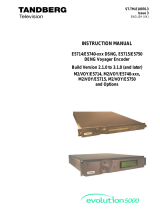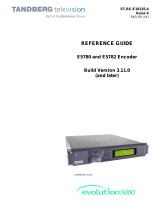
II. COMPONENT LOCATION AND WIRING CONSIDER-
ATIONS
WARNING: ELECTRICAL SHOCK HAZARD
Failure to follow this warning could result in personal
injury, death, or possible equipment damage.
Disconnect supply power before routing wire.
NOTE: All wiring must comply with national, state, and local
codes.
LOCATING SYSTEM ACCESS MODULE
— Since the System Access Module (SAM) uses two-way radio,
choose a potential mounting location that is as high and as close to
outside walls or windows as possible to attempt to maximize radio
coverage. The coverage is dependent on where the Skytel trans-
ceivers are located. If one location does not work, try the opposite
side to get the device in closer directional proximity. Temporarily
mount the System Access module in the intended permanent
mounting location until the radio test has passed 100%.
The System Access Module is approved for indoor use only and
should never be installed with any of its components exposed to
the elements. The System Access Module may be installed in any
area where the temperature remains between -4° and 158°F and
there is no condensation. The cover must be installed to prevent
damage from other sources. Do not locate where it will be
accessible to children. The SAM should be mounted in the vertical
position. Remember that wiring access and Skytel reception are the
most important considerations.
Select a location near the Evolution furnace or fan coil where
wiring from the User Interface, each Remote Room Sensor or
Smart Sensor, each damper actuator, and the equipment itself can
come together easily.
CAUTION: ELECTRICAL OPERATION HAZARD
Failure to follow this caution may result in equipment
damage or improper operation.
To prevent possible damage to the System Access Mod-
ule, do not mount on plenum, duct work, or flush against
furnace.
WIRING CONSIDERATIONS — Ordinary thermostat wire is
ideal when wiring the System Access Module (shielded cable is
not necessary). Use 22 AWG or larger for normal wiring. Lengths
over 100 ft. should use 20 AWG or larger wire.
III. CONNECT POWER SOURCE AND ANTENNA
Screw the antenna to the radio connector. See Fig. 3 for antenna
attachment location.
A separate 24 VAC transformer is included to power the System
Access Module. DO NOT connect the D-wire (24 VAC hot) from
the Evolution system.
The transformer is heavy. Make sure it is secured to the power
outlet with an appropriate screw through the boss on the trans-
former.
IV. RADIO TEST
The purpose of this test is to verify effective 2-way communica-
tions at the installation site. The test must pass 100% before the
installation of the SAM can continue.
Press and hold the RADIO TEST button for at least 5 seconds.
A flashing Yellow LED will indicate the test is in progress. A
flashing Yellow and Green LED means the transmission is
complete and the System Access Module is waiting for a reply. A
constant Green LED means the radio test has passed. The radio
will perform three message tests, so this sequence will occur three
times. If the System Access Module has errors during the process,
the test could take up to 15 minutes.
If the Red LED is lit solid, then the System Access Module failed
to send the message. Try a new mounting location for the System
Access Module.
If the Yellow LED is lit solid, then the System Access Module sent
its message but did not receive a reply. The Bryant server may be
down or the received signal is weak. Try a new mounting location
for the System Access Module.
Aborting Test - There is no method to abort a radio test once it is
started, other than to remove power.
The LEDs will maintain their state for 1 hour after the test.
Pressing the Radio Test button momentarily will clear the LEDs.
Pressing the Radio Test button again for five seconds will repeat
the radio test. See Fig. 2 for a description of the radio test and LED
sequence.
V. INSTALL COMPONENTS
INSTALL SYSTEM ACCESS MODULE — Once the radio test
has passed, the System Access Module can be permanently
installed. The System Access Module is designed so that wires can
enter it from behind, above, or below. Plan wire routing before
mounting.
1. Remove cover to access mounting holes.
2. Mount back plate to wall using screws and wall anchors
provided.
3. Level back plate and tighten screws.
VI. CONNECT EVOLUTION SYSTEMS
CAUTION: UNIT OPERATION HAZARD
Failure to follow this caution may result in improper unit
operation.
Improper wiring of the ABC connector will cause the
System Access Module to operate improperly. Check to
make sure all wiring is correct before proceeding with
installation or turning on power.
Connect the A, B, and C wires from the Evolution System to
terminals labeled A1, B1, and C1. Connect the second Evolution
System (if present) to the terminals labeled A2, B2, and C2.
ABC bus wiring only requires a three wire connection; however, it
is good practice to run thermostat cable greater than three wires in
the event of a damaged or broken wire during the installation.
It is recommended that the following color code be used when
wiring each ABC connector:
A — Green Data A
B — Yellow Data B
C — White 24VAC (Com)
NOTE: The D-wire (red - 24 VAC hot) from the Evolution
system is not connected to the System Access Module.
It is not mandatory that the above color code be used, but each
ABC connector in the system MUST be wired consistently.
VII. CONNECT AUXILIARY SENSOR (OPTIONAL)
The System Access Module will support a dry contact sensor for
use with water detection or some other use as seen fit. Connect one
side of the contacts to connector AUXC (common) and the other
side to connector AUX (input). The sensor input can provide up to
20mA at 5 volts d.c. If the sensor input is active, it will not shut
down or affect operation of the HVAC system(s). A pop-up
message will appear on the user interface indicating the auxiliary
sensor is active. The home owner will also be notified via e-mail
and/or phone if so chosen on the internet web interface.
VIII. SYSTEM START-UP
After a successful radio test has occurred, power may be applied to
the Evolution System(s). The user interface of the Evolution
System will automatically find the System Access Module at
—2—










